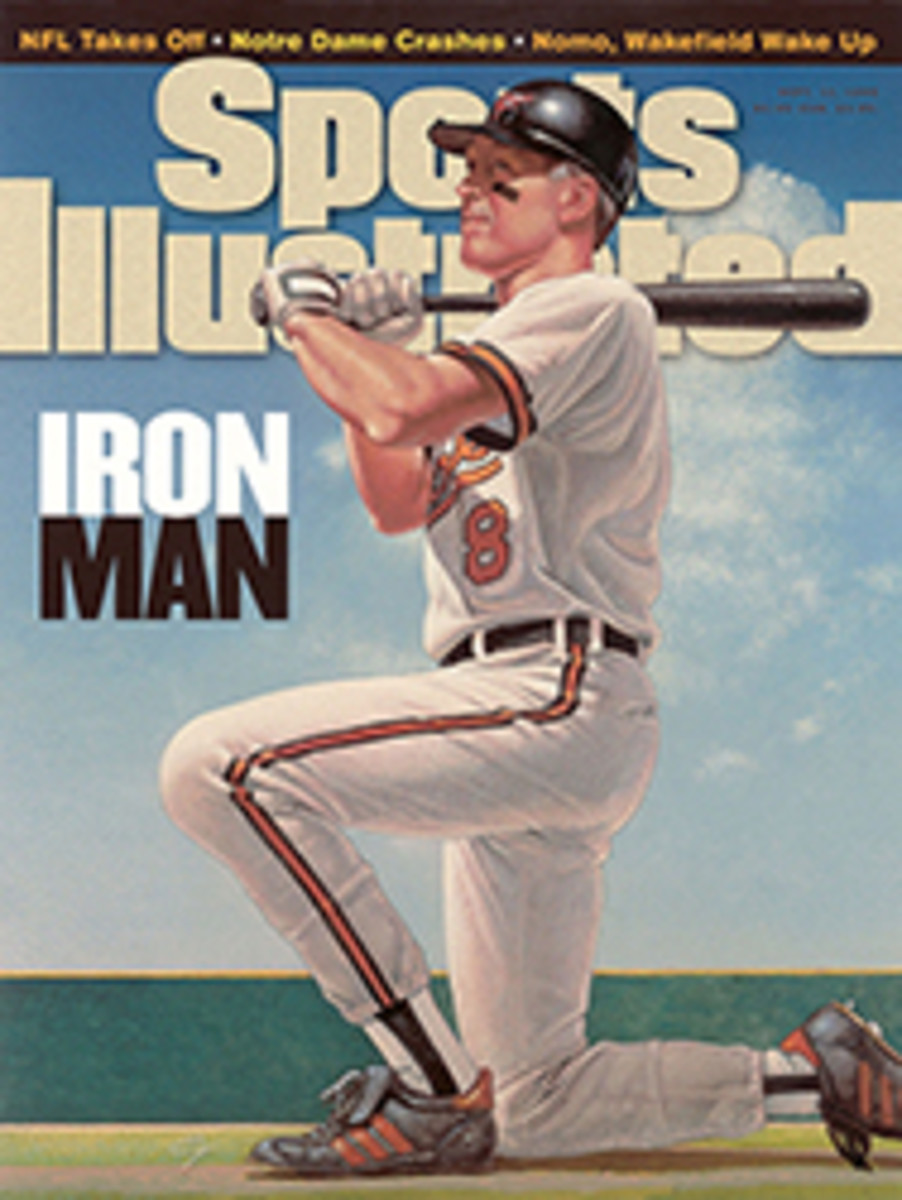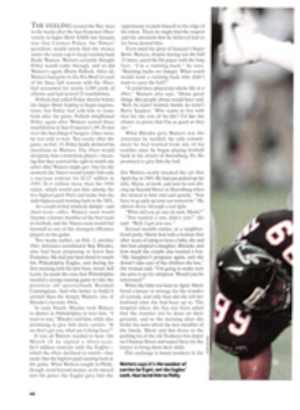
NOW YOU SEE IT... ...NOW YOU DON'T THE DECEPTIVE TIM WAKEFIELD AND HIDEO NOMO RECOVERED FROM PUZZLING SLUMPS
They have been baseball's master illusionists of 1995, from the
moment they seemingly appeared out of thin air themselves. All
of a sudden there was Tim Wakefield pitching for the Boston Red
Sox, back from oblivion (otherwise known as Buffalo), offering
up an inviting yet whimsical knuckleball with the kind of sleepy
speed that wouldn't stir a trooper on the Mass Pike. Likewise,
Hideo Nomo, fresh out of Japan, showed up on the Los Angeles
Dodger staff with his own sleight of hand, a fiendish forkball
that bottomed out faster than a Chevy Chase talk show. From two
different coasts the two of them mesmerized two different
leagues with two different signature pitches but with the same
M.O.: Now you see it, now you don't.
By Aug. 14 Wakefield and Nomo, both righthanders, were a
combined 23-4 while only once allowing more than three earned
runs over the 36 starts between them. No one else threw quite
like either one, much to the further frustration of hitters.
Wake field is erect and serene, floating the ball with an
economy of effort; Nomo fires it with an explosion of
leg-spinning, back-bending, head-turning, arm-whipping
contortionism.
The next 16 days, though, exposed the fragility of their
success, as each lost command of his staple pitch. They made six
combined starts in that time and gave up more than three earned
runs in every one of them (32 earned runs total over 32 2/3
innings) while going 1-4.
Exposed as captives to shallow, inherently fickle repertoires,
Wakefield and Nomo suddenly appeared vulnerable. Their magic, it
turned out, could be as elusive as their best stuff. Now you see
it, now you don't. "Nomo's been so outstanding for so long that
he can't slip up without it being a federal case," protested his
catcher, Mike Piazza, last week. "One thing we all go through is
a slump. Unless you're Greg Maddux, it's going to happen to
everybody."
Sure enough, as if by magic, the pitchers righted themselves.
Nomo (10-5, 2.47 ERA, National League-high 205 strikeouts
through Sunday) pitched 7 1/3 innings of two-hit, shutout ball
against the New York Mets last Thursday before leaving for the
second time in eight starts with a cracked nail on his right
middle finger. Wakefield (15-3, American League-low 2.44 ERA)
came back on Sunday and limited the California Angels to one run
on four hits in eight innings.
Nomo is essentially a two-pitch pitcher: He throws a fastball
and forkball. (He also throws a slow curve, though so rarely and
ineffectively that hitters can disregard it.) "It's tough being
a two-pitch pitcher in this league," says Piazza, "but so far
he's done it." Indeed, hitters seemed to have a harder time
solving Nomo the second time around. He was 3-3 with a 3.88 ERA
in the 12 games in which he faced a team for the first time and
7-2 with a 1.41 ERA in 11 follow-up games.
Wakefield has even fewer bullets in his arsenal than Nomo.
Without his good knuckle ball, Wakefield's batting-practice-
speed fastball and modest slider are worthless. "When you're
going good, people ask why don't more people throw the
knuckler," says Dodger knuckleball pitcher Tom Can di otti.
"When you're going the way Timmy was recently, that's when you
say, 'That's why.' It's the nature of the pitch. When you get
locked in, you feel like you can throw it for a strike any time
you want. But when you lose it just a little bit, it's not like
a fastball pitcher going from 95 miles per hour to 93. When it
goes wrong, it really goes wrong. You just lose the feeling on
it, give up some hits, lose your aggressiveness, walk a lot of
guys, and you're in deep trouble."
Wakefield's knuckleball is like a nervous banana-republic
dictator: It never takes the same route home. He cannot spot the
pitch because, he says, not even he knows how it is going to
break. It works best for him when he trusts his feel for
it--simply letting it fly off his fingertips unhurriedly--and
worst when he tries too hard to control its location and speed.
He is virtually unbeatable when the knuckler dances through the
strike zone, as evidenced by his 10-1 run with the Pittsburgh
Pirates in 1992 (including two playoff wins) and his 14-1 start
this season. He is awful when the pitch is either flat or wild.
(See 1993 and '94, when he went 14-31 overall with the Pirates
and minor league teams in Zebulon, N.C., and Buffalo, eventually
earning his release from the Pittsburgh organization.)
At one point this year Wakefield won 10 straight, the last of
those victories coming on Aug. 13, when he came within eight
outs of no-hitting the Baltimore Orioles. By then there was
speculation that he might win both the American League Cy Young
and Most Valuable Player awards. Reporters wanted him to tell
his life story over and over, about how he became a pitcher in
the minors in 1989 after failing to hit enough as an infielder,
about how knuckleball gurus Phil and Joe Niekro straightened him
out in spring training this year, and about what it's like
enduring a wild relationship--a pitcher and his disobedient
knuckler--that makes a Liz Taylor marriage look positively rock
solid.
The attention is largely unwanted by Wakefield. "It's definitely
been hard to keep my focus," he says. "I like to please people,
but I realize I'm not getting paid to answer questions or sign
autographs. And if my concentration is not fully there, then I'm
out of a job next year. I had a great 10-game streak when I was
locked in and could do what I wanted to do. That's gone."
Wakefield's magical run ended in Seattle on Aug. 18, when the
Mariners, who had squeezed one unearned run off him in 10
innings back in June, blasted him for seven runs in three
innings. They waited for him to get his knuckleball over the
plate, and he couldn't do it. The Mariners swung at only five of
his first 44 pitches. Third baseman Mike Blowers crushed a grand
slam and a three-run homer.
"The key is to be patient with him," says Blowers, "and when he
does come in with a fastball, to take advantage of it. The other
thing is, it seems like his good knuckle ball starts at about
the belt and breaks down out of the strike zone. The ones that
are up don't move as much. So you want him to get the
knuckleball up."
The loss in Seattle began a three-start slump in which Wakefield
went 0-2 with a 9.56 ERA while averaging 7.9 walks per nine
innings, about triple his previous rate. Hitters clearly had
learned to be patient with the knuckler--through Sunday they were
hitting .309 off him when they got to three-ball counts, .209
when they didn't--though, as Red Sox manager Kevin Kennedy says,
"if he throws it for a strike, as he did earlier in the season,
it doesn't matter."
Nomo, on the other hand, was slowed by a stiff elbow, an
aftereffect of throwing 120 pitches in a one-hitter against the
San Francisco Giants on the cool, windy night of Aug. 5. Los
Angeles pitching coach Dave Wallace says the stiffness lasted
"only one or two starts," but Nomo went 1-3 with a 6.20 ERA over
the next four. That stretch included the worst of his 23 starts,
a three-inning, seven-run disaster in a 17-4 loss to the
Philadelphia Phillies.
"Our club started swinging early in the count against the
fastball," says Philadelphia coach Larry Bowa. "If he's not
getting the forkball over, it doesn't matter how hard he throws,
because these guys are going to hit fastballs. And now we're in
the second half of the season, and the fatigue factor might be
coming into play. Your arm can only throw so many pitches. And
the more forkballs you throw, it takes away from your fastball.
It's a strain on your elbow. This guy throws a lot of forkballs,
so we'll see."
Says one National League general manager, "He's not popping his
fastball like he did early in the season." Nomo has averaged 110
pitches each time out and already has thrown 46 1/3 more innings
than he did last year, when he missed most of the second half of
the Japanese Pacific League season with shoulder trouble. "I
think he is a little tired," Piazza says, "but he says he's not."
Nomo actually throws two kinds of forkballs, which differ by as
much as 8 mph: a slow version that looks like a straight
changeup and a harder, "wipeout" forkball that is his strikeout
pitch. "It's so good," says Met shortstop Jose Vizcaino of the
latter delivery, "a lot of times you know it's coming, and you
still can't hit it. So you have to look for fastballs early in
the count."
Even though hitters have learned to sniff out fastballs from
Nomo and are less baffled by his funky delivery--"The first time
I faced him, all I did was try to figure out where his release
point was," says New York first baseman Rico Brogna--the league
is hardly catching up to him. For example, Nomo dominated Met
hitters last Thursday when he faced them for a fourth time.
Pitching on his 27th birthday, he permitted only two singles and
struck out 11. "Any questions now?" Wallace proudly asked after
the game.
That outing underscored the importance of his forkball. Nomo
overwhelmed New York despite flipping "only a couple" of
curveballs, Piazza says, and a fastball that reached 90 mph just
twice and dipped as low as 82 mph in the seventh inning. Nomo
left the following inning when the nail on his finger cracked,
an injury caused by the pressure on his finger when he throws
his fastball. "Did you see it? It's ugly," Piazza says. "It's
broken almost all the way down to the cuticle."
In fact, a small group of English-speaking reporters gathered at
Nomo's locker after the game and asked for a peek at the damaged
appendage. Covering his right hand with his left, Nomo said
through an interpreter, "No." Just one quick look? Again through
the interpreter came the unwavering response: "No." Nomo stood
and walked out, careful to keep his hand concealed, a magician
giving nothing away.
COLOR PHOTO: CHUCK SOLOMON When Tim Wakefield throws his nonrotating knuckler, the baseball world seems to stand still.
COLOR PHOTO: HEINZ KLUETMEIER With a contortionist's delivery and a drop-dead forkball, Nomo is hard to read even after a second look. [Hideo Nomo]
COLOR PHOTO: DAMIAN STROHMEYER During three games Wakefield lost the feel for his soft-toss pitch. [Tim Wakefield]
Their magic, it turned out, could be as elusive as their best
stuff.

